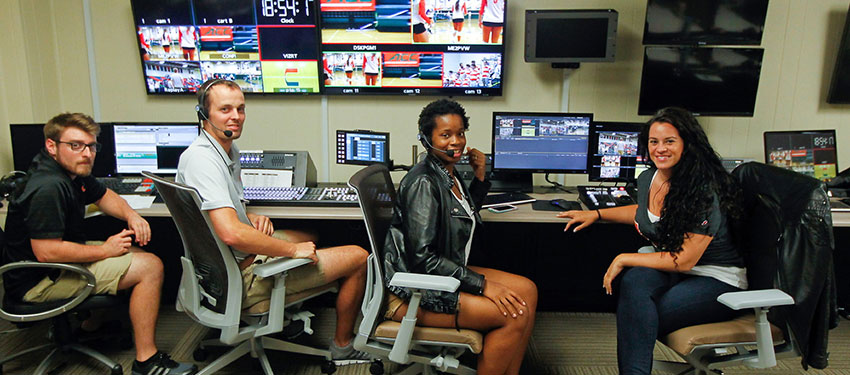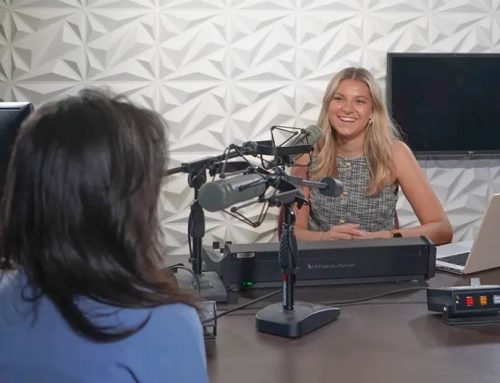Ratcheting up the tension in the control room, a voice on the speakerphone begins the countdown to the volleyball match against Boston College.
“Four minutes to live…Three minutes to live,” the producer from ESPN’s college headquarters intones, prompting University of Miami senior Bianca Anuforo to utter aloud what is on everybody else’s mind. “Oh, that’s nerve-wracking,” she says.
Such pre-game jitters are understandable. For the first time since UM Athletics began live-streaming games to ESPN’s Internet service six months ago, the production crew for this home volleyball match consists almost entirely of UM students. And like Anuforo, an education major who is sitting at the controls of the replay machine, most are filling critical roles in their first live broadcast.
Available to university students and all cable subscribers via the Internet, the broadcasts are made possible by the University’s $1 million investment in a state-of-the-art video control room on the second floor of the Hecht Athletic Center. Equipped with seven professional video cameras, and both portable and permanent replay, graphics, switching, and audio machines, UM is now able to broadcast two live games simultaneously—a valuable recruiting tool that is increasing exposure to University athletics, engaging more fans, and providing unparalleled, hands-on work experience to students through paid positions.
“Our goal is to make this a real teaching program, where students will learn how to operate all the equipment and even get a chance to direct,” said Jason Layton, senior associate athletics director for communications and sales.
On this October night, Drew Thomas, supervisor of video productions, sits in the technical director’s seat. Watching the live feed from the floor of the James L. Knight Sports Complex on the monitors overhead, he issues gentle orders to the three students in the control room, and the three others operating the cameras in the gym.
“Bring up the music during the breaks,” he tells graduate student Alexis Aarons, who is controlling the audio and on the speakerphone with ESPN. When she began her master’s in broadcasting, Aarons never dreamed she’d have this opportunity. “This is exactly what I want to do—sports broadcasting—so it’s great,” she says.
Addressing the videographers on his headset, Thomas asks one to “shake your camera if you can hear me.” “Push in a little bit on the band,” he tells another. “That means zoom in.”
He also issues a preemptory apology.
“If you mess up, don’t worry about it,’’ Thomas says. “I’ll get fired up a few times during the game, but don’t take it personal. It can get frantic in here.”
As if to punctuate his point, the feed from the stationary camera, which is operated from a lift, goes black with just one minute to live. But nobody panics and, as it turns out, Anthony Lestochi, a video production specialist who joined Thomas’ team two months ago, was averting catastrophe. He noticed the camera cord was caught in the lift, and momentarily unplugged it to untangle it.
Lestochi would perform the same utility, or grip function, for Marcus Alcindor, a motion pictures major who spent the game on the sidelines, rolling back and forth in a desk chair, zooming in on the players, the pep band, the fans, and coaches with the 25-pound camera mounted on his shoulder.
And that, Alcindor notes, is the big draw of the ESPN3 broadcasts, which now employ 20 students, most from the School of Communication. In the broadcast world, he knows he wouldn’t ordinarily start behind the camera. He’d be untangling the cords.
“But here they throw you right in,” Alcindor says. “I hadn’t filmed with that kind of camera before. It was heavy-duty serious. And it’s live, so you can’t do it over. I was a little anxious, but it was exciting.’’
With the backing of Athletic Director Blake James, Layton and Thomas began the University’s live-stream broadcasts during baseball season in much the same fashion—by learning as they went. Broadcasting the last dozen home baseball games from a portable control room at Mark Light Field, they relied on production freelancers from the Marlins, Heat, and Dolphins, and a lot of luck.
“It’s come a long way quickly,” Layton said. “Right now we’re expected to do 80 or 90 games total this year, but when we started, honestly, we were still practicing. We were literally setting things up minutes before the game.”
In addition to baseball and volleyball, UM Athletics is live streaming soccer and basketball games that are not televised.
The payoff, though, was immediate. More than 25,000 combined viewers tuned into the first two games the department produced in April, when UM baseball faced state rival FSU. The first game was a real test of endurance—for the team, and the broadcast crew. Ending after 1 a.m. and 17 innings, it lasted six hours.
On this night in October, the lady ’Canes volleyball team sweeps the Boston Eagles 3-0 in 90 minutes, preserving their at-home undefeated streak. After gathering for a triumphant group hug, outside hitter Taylor Scott, who led the team with five kills, says she’s thrilled her family could watch the game live from California.
“Some people get nervous with live TV, but I love it,” she says. “It motivates us. You know people are watching, so you get a different edge.”
Upstairs in the control room, the production crew is quietly celebrating their own streak. Even with students in the hot seat, they’ve yet to miss an ESPN3 deadline, or mess up a broadcast.
“Good job, guys,” Thomas says.
This article was originally published in UM News.







